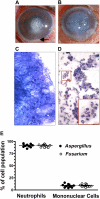Expression of innate and adaptive immune mediators in human corneal tissue infected with Aspergillus or fusarium
- PMID: 21828275
- PMCID: PMC3156922
- DOI: 10.1093/infdis/jir426
Expression of innate and adaptive immune mediators in human corneal tissue infected with Aspergillus or fusarium
Abstract
Background: Filamentous fungi of the genera Aspergillus and Fusarium are major causes of corneal ulcers in the United States and in the developing world and result in significant visual impairment and blindness.
Methods: RNA was extracted from 110 patients with corneal ulcers in southern India within 1 week of infection with either Fusarium solani or Aspergillus flavus, and gene expression was determined by quantitative polymerase chain reaction. Posttransplant corneas from later stage disease (>2 weeks after infection) were also examined.
Results: Expression of Dectin-1, Toll-like receptor 2 (TLR2), TLR4, TLR9, and NOD-like receptor protein (NLRP)3 messenger RNA was elevated >1000-fold compared with uninfected donor corneas, whereas Dectin-2 was constitutively expressed in uninfected corneas. Furthermore, interleukin 1β (IL-1β) expression was elevated >1000-fold, whereas IL-1α expression was not increased. Expression of IL-8, IL-17, and tumor necrosis factor α was also elevated. CD3(+)and CD4(+) T cells were detected in infected posttransplant corneas. Expression of IL-17 and interferon γ was elevated but not that of IL-4. There were no significant differences in the host response between Aspergillus- and Fusarium-infected corneas at any time point.
Conclusions: There is a common innate and adaptive immune response to these filamentous fungi, which includes the generation of T-helper 1 and T-helper 17 cells.
Figures




References
-
- Gaujoux T, Chatel MA, Chaumeil C, Laroche L, Borderie VM. Outbreak of contact lens-related Fusarium keratitis in France. Cornea. 2008;27:1018–21. - PubMed
-
- Chang DC, Grant GB, O’Donnell K, et al. Multistate outbreak of Fusarium keratitis associated with use of a contact lens solution. JAMA. 2006;296:953–63. - PubMed
-
- Khor WB, Aung T, Saw SM, et al. An outbreak of Fusarium keratitis associated with contact lens wear in Singapore. JAMA. 2006;295:2867–73. - PubMed
-
- Gower EW, Keay LJ, Oechsler RA, et al. Trends in fungal keratitis in the United States, 2001 to 2007. Ophthalmology. 2010;117:2263–7. - PubMed
Publication types
MeSH terms
Grants and funding
LinkOut - more resources
Full Text Sources
Other Literature Sources
Medical
Research Materials

